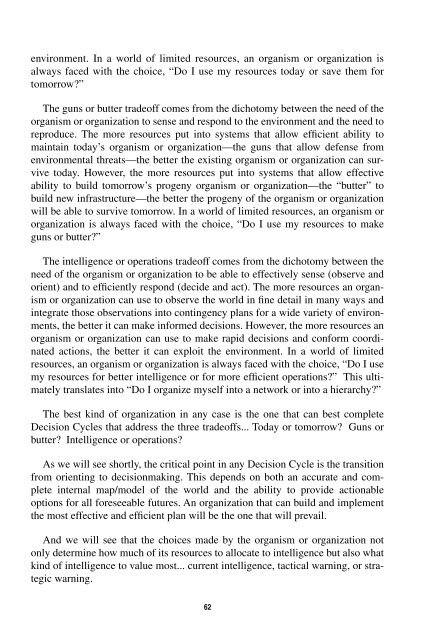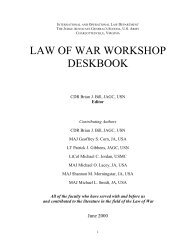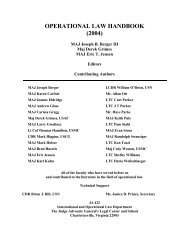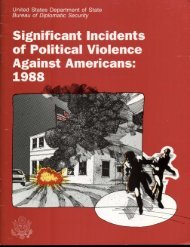Warning Analysis for the Information Age - Higgins Counterterrorism ...
Warning Analysis for the Information Age - Higgins Counterterrorism ...
Warning Analysis for the Information Age - Higgins Counterterrorism ...
You also want an ePaper? Increase the reach of your titles
YUMPU automatically turns print PDFs into web optimized ePapers that Google loves.
environment. In a world of limited resources, an organism or organization isalways faced with <strong>the</strong> choice, “Do I use my resources today or save <strong>the</strong>m <strong>for</strong>tomorrow?”The guns or butter tradeoff comes from <strong>the</strong> dichotomy between <strong>the</strong> need of <strong>the</strong>organism or organization to sense and respond to <strong>the</strong> environment and <strong>the</strong> need toreproduce. The more resources put into systems that allow efficient ability tomaintain today’s organism or organization—<strong>the</strong> guns that allow defense fromenvironmental threats—<strong>the</strong> better <strong>the</strong> existing organism or organization can survivetoday. However, <strong>the</strong> more resources put into systems that allow effectiveability to build tomorrow’s progeny organism or organization—<strong>the</strong> “butter” tobuild new infrastructure—<strong>the</strong> better <strong>the</strong> progeny of <strong>the</strong> organism or organizationwill be able to survive tomorrow. In a world of limited resources, an organism ororganization is always faced with <strong>the</strong> choice, “Do I use my resources to makeguns or butter?”The intelligence or operations tradeoff comes from <strong>the</strong> dichotomy between <strong>the</strong>need of <strong>the</strong> organism or organization to be able to effectively sense (observe andorient) and to efficiently respond (decide and act). The more resources an organismor organization can use to observe <strong>the</strong> world in fine detail in many ways andintegrate those observations into contingency plans <strong>for</strong> a wide variety of environments,<strong>the</strong> better it can make in<strong>for</strong>med decisions. However, <strong>the</strong> more resources anorganism or organization can use to make rapid decisions and con<strong>for</strong>m coordinatedactions, <strong>the</strong> better it can exploit <strong>the</strong> environment. In a world of limitedresources, an organism or organization is always faced with <strong>the</strong> choice, “Do I usemy resources <strong>for</strong> better intelligence or <strong>for</strong> more efficient operations?” This ultimatelytranslates into “Do I organize myself into a network or into a hierarchy?”The best kind of organization in any case is <strong>the</strong> one that can best completeDecision Cycles that address <strong>the</strong> three tradeoffs... Today or tomorrow? Guns orbutter? Intelligence or operations?As we will see shortly, <strong>the</strong> critical point in any Decision Cycle is <strong>the</strong> transitionfrom orienting to decisionmaking. This depends on both an accurate and completeinternal map/model of <strong>the</strong> world and <strong>the</strong> ability to provide actionableoptions <strong>for</strong> all <strong>for</strong>eseeable futures. An organization that can build and implement<strong>the</strong> most effective and efficient plan will be <strong>the</strong> one that will prevail.And we will see that <strong>the</strong> choices made by <strong>the</strong> organism or organization notonly determine how much of its resources to allocate to intelligence but also whatkind of intelligence to value most... current intelligence, tactical warning, or strategicwarning.62
















